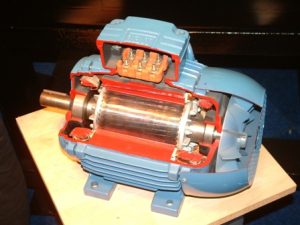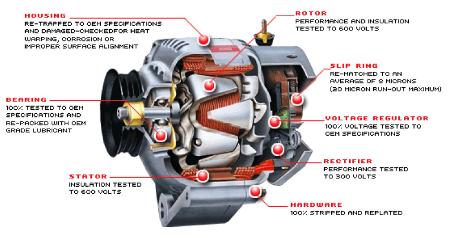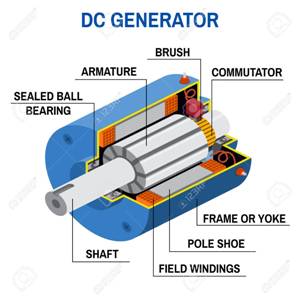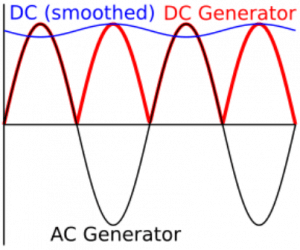The rotating machines function on the same principle of electromagnetic induction those are the motor and the generator. Even though the principle is the same their the output they deliver differs due to the operational difference. This difference in operation is important for the machines to be classified as either a motor or a generator. Similarly, the individual machines can also be classified as ac or dc typed depending on the input and output they deliver. So, let us discuss in detail about this topic. In this topic, the basics of what an electrical generator, its classification, and the contrast between them will be discussed.
What is an Electrical Generator
It is a machine that transforms the input mechanical energy to electrical energy based on the principle of electromagnetic Induction. As stated by the faradays’ law of electromagnetic induction, an EMF is induced whenever a conductor cuts the magnetic flux of lines. This EMF induced causes a current to flow in the conductors. This direction of current is found by using Flemings’ right-hand rule. The figure that depicts an electrical generator is shown in the figure below.

Electrical Generator
Depending upon the output obtained it is classified into AC and DC generators. The detailed working difference between these two generators is studied in this article.
Please refer to this link to know more about DC Generator MCQs
What is an AC Generator
An AC generator is a type of electrical generator that transforms the input mechanical energy to an output of AC (alternating) electrical energy. The AC generator components figure is shown in the figure below.

AC Generator
What is a DC Generator
A DC generator is also a type of electrical generator that transforms the input mechanical energy to an output of DC (one-directional) electrical energy. The DC generator components figure is shown in the figure below.

DC Generator Diagram
Difference Between AC and DC Generator
- The only constructional difference between the AC and DC generator is that the AC generator uses slip rings whereas the DC generator uses the commutator to produce unidirectional current.
- Slip rings are used in an AC generator where the ends of the coil are connected in order to obtain a smoother operation. The directional of the current through the coil changes for every cycle in the AC generator.
- Split ring commutator is used in the DC generator to change the current direction to unidirectional. As the split rings are of two separate segments the alternating current through the coil can be changed.
- The waveform representation of both the machines is shown in the figure below.

AC&DC Generator waveform
The tabular form of representation of both the machines is shown in the figure below to have a better understanding.
| AC Generator | DC Generator |
| An AC generator is a type of an electrical generator that transforms the input mechanical energy into an output of AC electrical energy | A DC generator is a type of an electrical generator that transforms the input mechanical energy into an output of DC electrical energy |
| The direction of the current changes continuously | The direction of the current does not change. It is unidirectional. |
| AC generators do not have a commutator | DC generators have a commutator |
| Slip rings are used in AC generators. These are used for the operation to be performed smoothly. | Split rings are used in DC generators. These are used to convert the direction of the current from alternating to unidirectional. |
| Brushes are highly efficient. Due to the high efficiency, the life expectancy of the generator is increased. | It is less efficient due to the split ring commutators. The life expectancy is less compared to AC generators. |
| Brushes are connected to slip rings for smooth operation. | Brushes are connected to split rings commutators to change the direction of the current. |
| As the brushes are highly efficient there is less chance of occurrence of short-circuiting. | As the brushes are less efficient there is more chance of occurrence of short-circuiting. |
| As the current changes frequently, the magnitude and amplitude changes. So, the frequency is also variable | As the current does not change frequently, it has constant magnitude and amplitude. So, the frequency is constant here. |
| These generate a very high voltage. | These generate low voltage compared to that of AC generators. |
| The generated voltage can be easily transmitted or distributed. | It is difficult to transmit the voltage. |
| AC generators are classified into three induction generators, single-phase, and synchronous generators. | DC generators are classified as self-excited and separately excited. Depending on the winding placed these are further classified as series, shunt, and compound generators. |
| These are highly efficient as the losses are less. | These are less efficient due to the less inefficiency of split ring operation. As it is not a smooth operation. |
| Design is simple | Design is complex |
| Requires less maintenance | Requires less maintenance |
| It is highly reliable | It is less reliable compared to AC generators |
| It requires high investment initially | It requires less investment initially |
| These are used in small power applications like mixer grinders, etc at homes. | These are used in large power applications. |
Thus, in this article, we studied the difference between the AC generator and the DC generator. The main constructional difference between the AC and DC generator is that the usage of a commutator. In AC generator we use slip rings for smooth operation whereas in the DC generator a split-ring commutator is used for changing the direction of the current. Apart from this, we also discussed the basics of both the machines and the tabular form of differentiation between the AC and DC generator. Here is a question for the readers, How does electrical generator work?

Leave a Reply